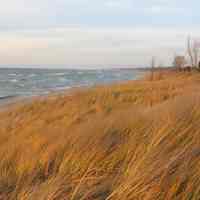Dune Grass

2023.50.106
SDHS NL InsertsNature, ecology, the landscape
Winthers, Sally
2023.50
Found in Collection
SDHS Newsletter insert pages 398
Digital data in CatalogIt
Simonds, Bob 1930-2021Simonds, O.C. 1855-1931
This information was OCR text scanned from SDHS newsletter supplements. Binders of original paper copies are in the SDHC reference library.
Many call it beach grass, some call it dune grass, others refer to it as Marrow Grass, and a select few call it, Ammophila breviligulata. But then, "what's in a name. That which we call:" beach grass or dune grass did, without question, save our dunes and shoreline from devastating erosion a little over 100 years ago. About twenty years after the great Chicago Fire of 1871, O.C. Simonds, a well known Chicago Landscape Architect, introduced at Pier Cove the perfect anti-erosion plant known as beach grass. More than any other plant, beach grass has done the major job of holding the Lake Michigan sand from being blown away. It has adapted to the severe conditions along the shoreline, and managed to thrive where most other plants would only wither and die. As the sand builds up around the individual plant, the grass grows higher and its root system adapts going ever deeper to reach a source of water. Although it is usually planted in plugs, it will self seed even in strong winds. This grass usually stays on the beach or dunes seldom competing with other plants that need less sun and more water. Back in 1996 and 1997 when the water level was high, there was a lot of damage done to the shoreline. Today, the beach grass has recaptured much of the lost sand and the shoreline has been stabilized. Many members and residents learned more about O.C. Simonds and the special grass he introduced it the 1890's at the Saugatuck-Douglas Heritage Festival in September. There were also guided tours of O.C. Simonds Trust Ravine.
01/07/2024
01/07/2024


